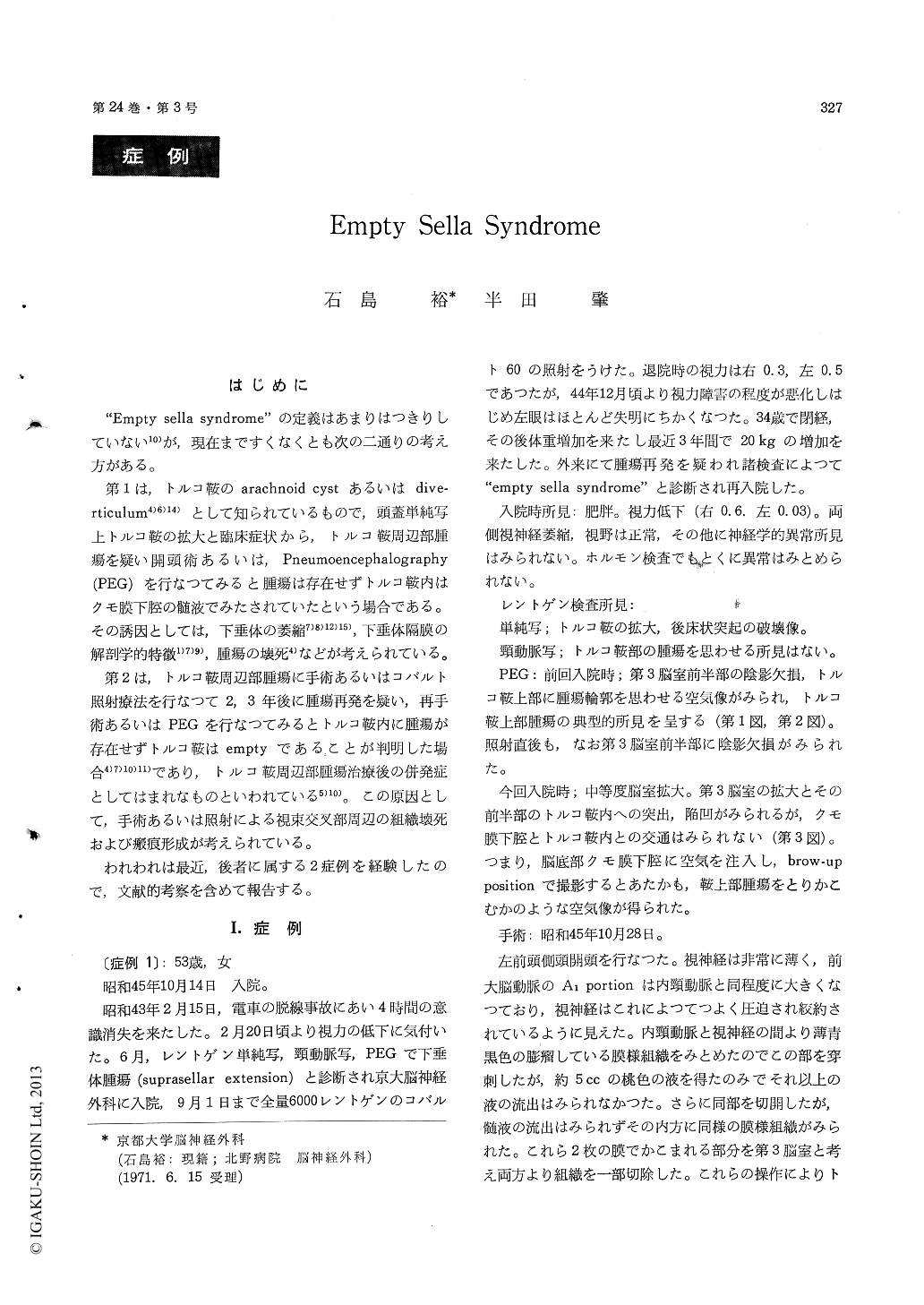Japanese
English
- 有料閲覧
- Abstract 文献概要
- 1ページ目 Look Inside
はじめに
"Empty sella syndrome"の定義はあまりはつきりしていない10)が,現在まですくなくとも次の二通りの考え方がある。
第1は,トルコ鞍のarachnoid cystあるいはdive—rticulum4)6)14)として知られているもので,頭蓋単純写上トルコ鞍の拡大と臨床症状から,トルコ鞍周辺部腫瘍を疑い開頭術あるいは,Pneumoencephalography(PEG)を行なつてみると腫瘍は存在せずトルコ鞍内はクモ膜下腔の髄液でみたされていたという場合である。その誘因としては,下垂体の萎縮7)8)12)15),下垂体隔膜の解剖学的特徴1)7)9),腫瘍の壊死4)のなどが考えられている。
We are reporting two cases of the "empty sella syndrome" complicated following the irradiation and operation of pituitary, tumor and cranio-pharyngioma.
Case 1 ; A 53-year-old woman was hospitalized in June, 1968, because of a 4-month history of poor vision without visual field defects. Her optic discs were pale. Plain films of skull demonstrated an enlarged sella. A large pituitary tumor with suprasellar extension was suspected by pneumoence-phalography. Irradiation therapy with Cobalt 60in a total dose of 6000 r. for a presumed chromo-phobe adenoma was completed. About one year later, however, her vision started to deteriorate again. A pneumoencephalogram revealed the di-lated third ventricle, the anterior portion of which protruded completely into the enlarged sella which did not, however, communicate with the basal cis-terns. An exploratory operation in October, 1970, showed that a menbraneous tissue was bulging between the left internal carotid artery and the optic nerve, but no tumor was found. Postopera-tively, she complained hypotension, diabetes in-cipidus, tremor on the right hand and right homo-nymous hemianopsia, the last of which was puz-zling. No change occurred in the visual acuity.
Case 2; A 12-year-old girl was operated on under a diagnosis of craniopharyngioma in August, 1966. A cyst was evacuated and drained to the left temporal muscle with a Nelaton catheter. The left optic nerve was injured during the operation. Postoperatively, Cobalt 60 was irradiated in a total dose of 6000 r. In October, 1969, convulsive seizures attacked her which could have hardly been con-trolled by anticonvulsant drugs. Her neurological deficits at the second admittion, on 20th April, 1970, inclued the impaired visual acuity and the temporal hemianopsia on the right eye, diabetes incipidus and panhypopituitarism. Pneumo-encephalogram revealed dilated third ventricle and the infundibular portion of it was protruded into the enlarged sella turcica. Air bubles in the sella had no communication with the subarachnoid space. A left recraniotomy was performed in May, 1970. Strongly firm adhesion between pia and dura mata, and fibrous scar tissues were found around the sella folding the optic nerve and the optic chiasm. No tumor could, however, been found either in or around the sella.
The "empty sella syndrome" is poorly defined. There have been at least two entities : the first is so called "subarachnoid cyst" or "subarachnoid diverticulum" of the sella turcica in which, al-though the enlarged sella demonstrated by plainskull film and neuro-ophthalmologic findings make one have a suspicion of a pituiatry tumor, no tumor in the chiasmal region could be found by an explorative surgery and/or pneumoencephalo-graphy. The second is the definition described by Colby and Kearns in 1962, as "A rather rate com-plication of irradiation is the 'empty sella syn-drome', in which a patient, treated a number of years previously with improvement in vision, later experiences visual impairment and is operated on with the presumption that his tumor is growing again. At operation no tumor is found ; the sella contains only some dense scar tissue and portions of the optic chiasm and optic nerve which the scar has drawn into it. This is the apparent cause of recurrent visual disturbance". Our cases are similar to the second group. The difference be-tween these two definition mentioned above is whether the patient has experienced a previous treatment of irradiation or not.
Generally, the sella turcica of the empty sella syndrome reported by many authors so far had had free communication with the subarachnoid space but never with the third ventricle. Contrarily, our both cases had not been communicated with the subarachnoid space but the content of the enlarged sella was anterior portion of the third -ventricle. The causative factors which presents the symptoms in our cases are thought to be chronic arachnoiditis and scar formation around the optic chiasm due to radiation, the compression to the optic nerve and the optic chiasm by the dilated third ventricle and pulsating transmission of the cerebrospinal fluid. Some controversiel points on neurological and neuroradiological findings in our cases are discussed.
It was stressed that any therapeutic procedure including operation and irradiation should never be done without the previous fractional pneumo-encephalography or pneumocisternography on the patients with suspcion of tumors in around the sella.

Copyright © 1972, Igaku-Shoin Ltd. All rights reserved.


